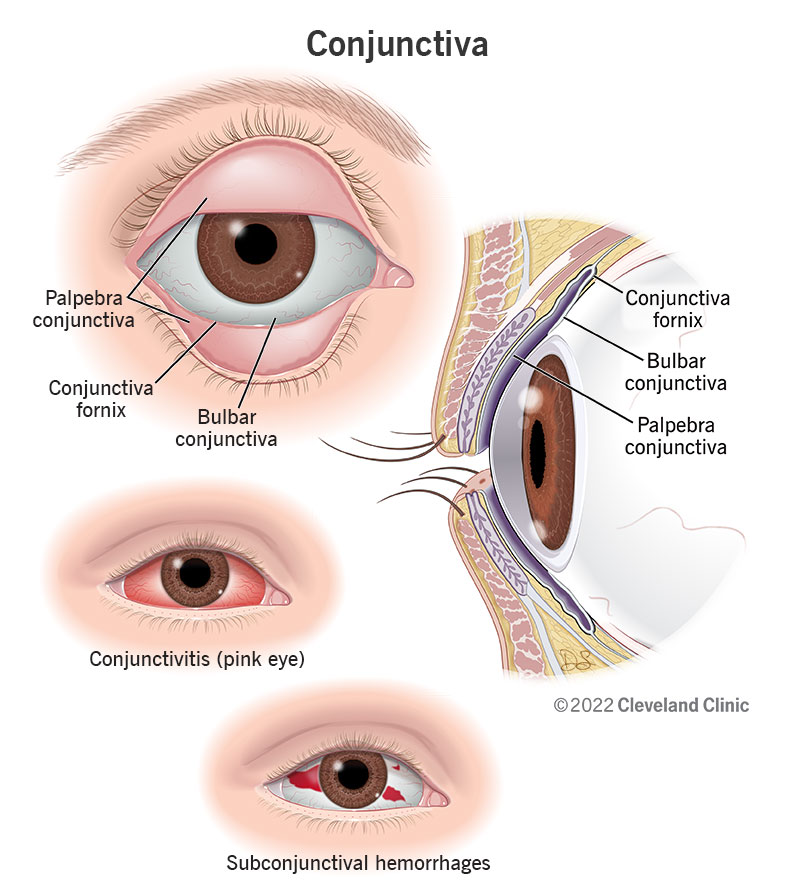The conjunctiva keeps your eye lubricated and prevents irritants from getting in. It works with a few glands to create your tears and protects the white part of your eyes from damage. Common conditions like pink eye (conjunctivitis) and subconjunctival hemorrhages are usually minor issues that require very little treatment.
Advertisement
Cleveland Clinic is a non-profit academic medical center. Advertising on our site helps support our mission. We do not endorse non-Cleveland Clinic products or services. Policy

The conjunctiva is a thin, clear membrane that protects your eye. It covers the inside of your eyelid and the white of your eye (the sclera).
Advertisement
Cleveland Clinic is a non-profit academic medical center. Advertising on our site helps support our mission. We do not endorse non-Cleveland Clinic products or services. Policy
The conjunctiva creates the mucus layer that forms part of your tears.
The conjunctiva protects and lubricates your eye. It’s a barrier between your eye’s vulnerable tissues and anything that could irritate them. The conjunctiva covers the white part of your eye. Your cornea covers the iris (the colored part of your eye) and pupil (the black center of your eye).
The conjunctiva works with your lacrimal glands and meibomian glands to make your tears. Your lacrimal glands make the watery part of tears. That watery liquid combines with mucus made by your conjunctiva and oil from your meibomian glands to create tears.
Think about the conjunctiva like a thin, clear sheet that covers the whites of your eyes. It acts like a combination of a raincoat and plastic wrap. It blocks irritants (like allergens) from getting into your eye and keeps moisture and lubrication sealed in.
You might develop dry eyes or an eye infection if something’s wrong with your conjunctiva.
The conjunctiva lines the inside of your eyelids and covers the white parts of your eyes.
The conjunctiva is made of three parts:
Advertisement
The most common conditions that affect the conjunctiva are pink eye (conjunctivitis) and subconjunctival hemorrhages.
Pink eye is a common eye infection. It’s caused by allergens, irritants, bacteria and viruses. Which treatment you’ll need depends on what’s causing the irritation in your conjunctiva.
A subconjunctival hemorrhage is the medical term for a broken blood vessel on the surface of your eye. The red spots caused by subconjunctival hemorrhage can look scary, but most cases don’t cause any symptoms or need treatment.
Visit an eye care specialist if you notice any symptoms in your eyes, including:
Tell an eye care specialist about any changes in your vision. If you wear glasses or contact lenses, have your eyes examined regularly. Your eye care specialist will adjust your prescription as often as necessary.
Make sure you’re wearing proper eye protection for any sport or activity that could cause an eye injury.
Visit an eye care specialist as soon as you notice any changes in your vision. Whether it’s something as simple as needing new glasses, or a more serious condition, don’t wait for symptoms to get worse before having your eyes checked.
Go to the emergency room if you’re experiencing severe eye pain or suddenly lose your vision.
The conjunctiva is a barrier between your eyes and the outside world. It keeps your eyes safe and lubricated.
It’s usually easy to tell if something is irritating your conjunctiva because the whites of your eyes will be red, itchy or feel dry. Visit an eye care specialist as soon as you notice any symptoms in your eyes. Even a small irritation can get worse over time if it’s not diagnosed.
Advertisement
Cleveland Clinic’s primary care providers offer lifelong medical care. From sinus infections and high blood pressure to preventive screening, we’re here for you.

Last reviewed on 10/22/2022.
Learn more about the Health Library and our editorial process.